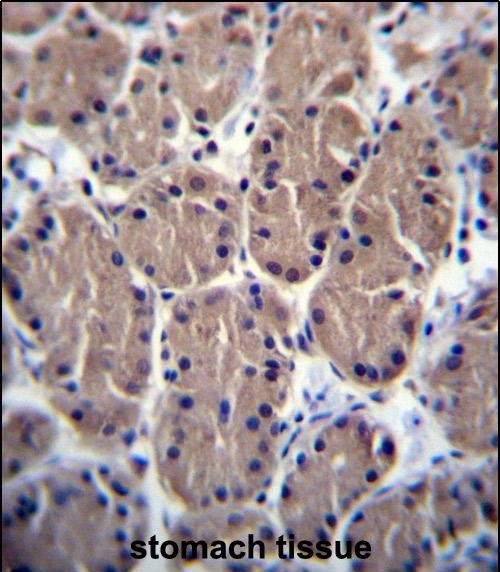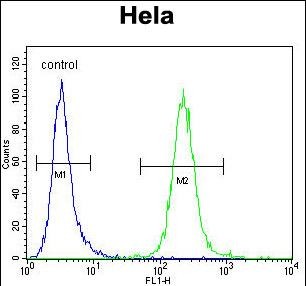POLR1B Antibody (N-term)
Affinity Purified Rabbit Polyclonal Antibody (Pab)
- SPECIFICATION
- CITATIONS
- PROTOCOLS
- BACKGROUND

Application
| FC, IHC-P, WB, E |
|---|---|
| Primary Accession | Q9H9Y6 |
| Other Accession | O54888, NP_061887.2, NP_001131076.1 |
| Reactivity | Human |
| Predicted | Rat |
| Host | Rabbit |
| Clonality | Polyclonal |
| Isotype | Rabbit IgG |
| Calculated MW | 128229 Da |
| Antigen Region | 89-117 aa |
| Gene ID | 84172 |
|---|---|
| Other Names | DNA-directed RNA polymerase I subunit RPA2, RNA polymerase I subunit 2, DNA-directed RNA polymerase I 135 kDa polypeptide, RPA135, POLR1B |
| Target/Specificity | This POLR1B antibody is generated from rabbits immunized with a KLH conjugated synthetic peptide between 89-117 amino acids from the N-terminal region of human POLR1B. |
| Dilution | WB~~1:1000 IHC-P~~1:10~50 FC~~1:10~50 |
| Format | Purified polyclonal antibody supplied in PBS with 0.09% (W/V) sodium azide. This antibody is purified through a protein A column, followed by peptide affinity purification. |
| Storage | Maintain refrigerated at 2-8°C for up to 2 weeks. For long term storage store at -20°C in small aliquots to prevent freeze-thaw cycles. |
| Precautions | POLR1B Antibody (N-term) is for research use only and not for use in diagnostic or therapeutic procedures. |
| Name | POLR1B {ECO:0000303|PubMed:31649276, ECO:0000312|HGNC:HGNC:20454} |
|---|---|
| Function | Catalytic core component of RNA polymerase I (Pol I), a DNA- dependent RNA polymerase which synthesizes ribosomal RNA precursors using the four ribonucleoside triphosphates as substrates. Transcribes 47S pre-rRNAs from multicopy rRNA gene clusters, giving rise to 5.8S, 18S and 28S ribosomal RNAs (PubMed:34671025, PubMed:34887565, PubMed:36271492, PubMed:11250903, PubMed:11283244, PubMed:16858408). Pol I-mediated transcription cycle proceeds through transcription initiation, transcription elongation and transcription termination stages. During transcription initiation, Pol I pre-initiation complex (PIC) is recruited by the selectivity factor 1 (SL1/TIF-IB) complex bound to the core promoter that precedes an rDNA repeat unit. The PIC assembly bends the promoter favoring the formation of the transcription bubble and promoter escape. Once the polymerase has escaped from the promoter it enters the elongation phase during which RNA is actively polymerized, based on complementarity with the template DNA strand. Highly processive, assembles in structures referred to as 'Miller trees' where many elongating Pol I complexes queue and transcribe the same rDNA coding regions. At terminator sequences downstream of the rDNA gene, PTRF interacts with Pol I and halts Pol I transcription leading to the release of the RNA transcript and polymerase from the DNA (PubMed:34671025, PubMed:34887565, PubMed:36271492, PubMed:11250903, PubMed:11283244, PubMed:16858408). Forms Pol I active center together with the largest subunit POLR1A/RPA1. Appends one nucleotide at a time to the 3' end of the nascent RNA, with POLR1A/RPA1 contributing a Mg(2+)-coordinating DxDGD motif, and POLR1B/RPA2 participating in the coordination of a second Mg(2+) ion and providing lysine residues believed to facilitate Watson-Crick base pairing between the incoming nucleotide and the template base. Typically, Mg(2+) ions direct a 5' nucleoside triphosphate to form a phosphodiester bond with the 3' hydroxyl of the preceding nucleotide of the nascent RNA, with the elimination of pyrophosphate. Has proofreading activity: Pauses and backtracks to allow the cleavage of a missincorporated nucleotide via POLR1H/RPA12. High Pol I processivity is associated with decreased transcription fidelity (PubMed:34671025, PubMed:34887565, PubMed:36271492, PubMed:11250903, PubMed:11283244, PubMed:16858408, PubMed:16809778) (By similarity). |
| Cellular Location | Nucleus, nucleolus. Chromosome {ECO:0000250|UniProtKB:P70700} |

Thousands of laboratories across the world have published research that depended on the performance of antibodies from Abcepta to advance their research. Check out links to articles that cite our products in major peer-reviewed journals, organized by research category.
info@abcepta.com, and receive a free "I Love Antibodies" mug.
Provided below are standard protocols that you may find useful for product applications.
Background
Eukaryotic RNA polymerase I (pol I) is responsible for the transcription of ribosomal RNA (rRNA) genes and production of rRNA, the primary component of ribosomes. Pol I is a multisubunit enzyme composed of 6 to 14 polypeptides, depending on the species. Most of the mass of the pol I complex derives from the 2 largest subunits, Rpa1 and Rpa2 in yeast. POLR1B is homologous to Rpa2 (Seither and Grummt, 1996 [PubMed 8921381]).
References
Wen, L., et al. Biochem. Biophys. Res. Commun. 367(4):846-851(2008)
Wu, C., et al. Proteomics 7(11):1775-1785(2007)
Johnson, S.S., et al. Mol. Cell 26(3):367-379(2007)
Panova, T.B., et al. Mol. Cell. Biol. 26(16):5957-5968(2006)
Percipalle, P., et al. EMBO Rep. 7(5):525-530(2006)
If you have used an Abcepta product and would like to share how it has performed, please click on the "Submit Review" button and provide the requested information. Our staff will examine and post your review and contact you if needed.
If you have any additional inquiries please email technical services at tech@abcepta.com.













 Foundational characteristics of cancer include proliferation, angiogenesis, migration, evasion of apoptosis, and cellular immortality. Find key markers for these cellular processes and antibodies to detect them.
Foundational characteristics of cancer include proliferation, angiogenesis, migration, evasion of apoptosis, and cellular immortality. Find key markers for these cellular processes and antibodies to detect them. The SUMOplot™ Analysis Program predicts and scores sumoylation sites in your protein. SUMOylation is a post-translational modification involved in various cellular processes, such as nuclear-cytosolic transport, transcriptional regulation, apoptosis, protein stability, response to stress, and progression through the cell cycle.
The SUMOplot™ Analysis Program predicts and scores sumoylation sites in your protein. SUMOylation is a post-translational modification involved in various cellular processes, such as nuclear-cytosolic transport, transcriptional regulation, apoptosis, protein stability, response to stress, and progression through the cell cycle. The Autophagy Receptor Motif Plotter predicts and scores autophagy receptor binding sites in your protein. Identifying proteins connected to this pathway is critical to understanding the role of autophagy in physiological as well as pathological processes such as development, differentiation, neurodegenerative diseases, stress, infection, and cancer.
The Autophagy Receptor Motif Plotter predicts and scores autophagy receptor binding sites in your protein. Identifying proteins connected to this pathway is critical to understanding the role of autophagy in physiological as well as pathological processes such as development, differentiation, neurodegenerative diseases, stress, infection, and cancer.




